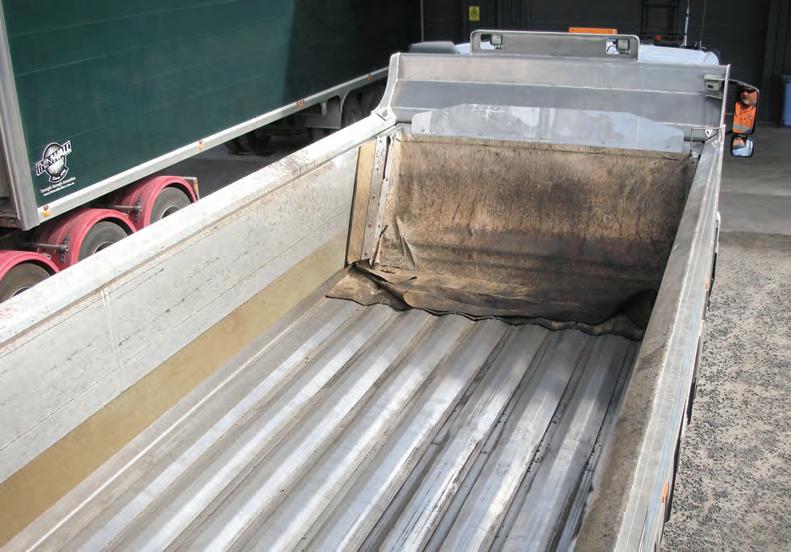INVESTING IN
EME2
TAPPING INTO THE EXPERIENCE AND CAPABILITIES OF COLAS GLOBAL GROUP, SAMI BITUMEN HAS SIGNIFICANTLY INVESTED IN RESEARCH, BY CONTRIBUTING TO THE DEVELOPMENT OF THE EME2 TECHNOLOGY TO HELP FACILITATE THE TECHNOLOGY TRANSFER AS A HIGH PERFORMANCE STRUCTURAL BASE COURSE FOR AUSTRALIA.
SAMI’s EME2 is produced at its specialist Port-of-Brisbane facility.
E
nrobé à Module Élevé Class 2 or (EME2) asphalt was originally developed in France in the early 1990s and is currently widely used across the world. It has been used in more recent years in Southern Hemisphere countries like South Africa, Reunion, Mauritius and New Caledonia. EME2 is a high modulus asphalt base course yielding very high stiffness, durability and significantly improved pavement performance. In 2017, an Austroads report found more than 28,000 tonnes of EME2 had been laid across Australia and since then its popularity and demand has continued to increase. The report stated that EME2 mix incorporates a very hard paving grade bitumen with a relatively high binder content, at around six per cent by mass. To facilitate the usage of this generic structural asphalt material into Australia, SAMI Bitumen Technologies invested in binder engineering technology. It also worked closely with contractors and Australian road authorities to duplicate 26
ROADS SEPTEMBER 2020
the same performance expectations as achieved in France. Key to the production of EME2 asphalt is having bitumen with the right binder properties which will ensure that the asphalt can achieve the target performance properties. SAMI Bitumen Technologies is now a producer of EME2 binder in Australia, with most of the company’s product manufactured in a specialist facility at Portof-Brisbane in Queensland. SAMI has also recently commissioned a specialised facility in Kwinana so it could also supply the hard grade of bitumen to the Western Australian market. Phil Stevens, SAMI’s Queensland State Manager says that the facility is home to an oxidising column which is generally required for obtaining a range of bitumen classes. “Oxidisation changes the properties of the bitumen to a higher, stiffer grade in a controlled way. The idea is to be able to obtain stiffer grades of bitumen without detrimentally impacting on their quality,” he says.
“At our Port-of-Brisbane facility, we generally receive one grade of bitumen that we subsequently engineer into the range of grades that the market requires.” Stevens says that in order to ensure the right oxidising parameters and conditions are being met, the experienced SAMI team consistently monitor the binder throughout the oxidation process. “We are testing the product as it is discharged from the cargo vessel, in-line, in our storage tanks on-site, as it moves through the preheating stage, into the blowing column and then right through to the industrial base product that is produced. Then we test it as it is corrected and finetuned to obtain the finished product, which is then finally tested for compliance.” “That isn’t even where the quality monitoring finishes, as samples of the binder are taken at the point of loading into the road tanker, at point of delivery at the asphalt plant and from the mix production tank. For EME2 the constant quality focus is intense.” Stevens says that fundamentally, it is the expertise of the SAMI team at the Port-ofBrisbane that ensures a quality final product. “SAMI is able to consistently provide quality bitumen so that an asphalt contractor can always be assured the EME2 mix they manufacture will reflect mix design performance properties. That is due to the quality of the base bitumen we use, the state-of the-art equipment and our experienced and well-trained people.” Iulian Man, SAMI’s Technical Services Manager, says SAMI Bitumen Technologies’ EME2 binder must meet stringent binder specifications but also it has to impart certain characteristics to the EME2 mix in order to meet the performance based specification. “When EME2 technology was first introduced to Australia, the European specification for EME2 was implemented locally by the road authorities and through intense research and resource allocation, we managed to create an EME2 binder that met

















